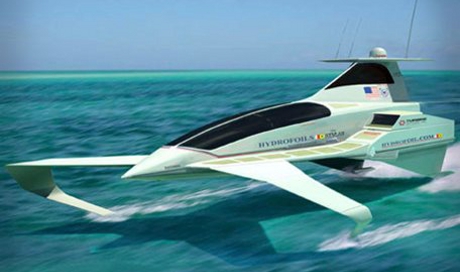
The search for unlimited speed has challenged many to push what a boat can do. The same could be said for aviators. However, to find innovators interested in both is a rarity.
The hydrofoil has been around for decades but is a form of transportation that seems like a novelty to some and a mystery to others. For Kenneth Cook, president of Hydrofoils Inc., Lake Worth, FL, it's been his life. Seventy two now, he started at the age of six learning how to build small boats and was racing by 13. His passion evolved into hydrofoils. "We were racing boats, my grandfather had a yacht and we drove to races," he recalls. "I saw major problems with hydrofoils in terms hydroplaning evolving and it's been an ongoing continuum of always trying to get a better standard. Some of them have airplane configurations with four wheels and some with foils, but it's always a very interesting and challenging process."
The difference between a regular boat and hydrofoil? "In a regular boat you have to push all the water out of the way when you proceed forward," he says. "Ever moved a 55-gallon drum full of water? A boat is like going through the water with a bunch of those stacked but a hydrofoil is flying up over it and there is less displacement, less water. There's also less fuel that you'll have to use." In fact, Cook's company site, hydrofoil.com, estimates 30% greater efficiency to similar marine vehicles for his 50G Zytiron model.
Still, the whole vehicle is more closely related to the airplane than the boat, Cook says. And the weight it should be designed for depends on where it's going to run. "You need to ask these kinds of questions: If it's mostly going to be in the ocean then what's the wave frequency? Or is it going to be in a bay or a river? Do you want to design it to run in shallow water or is it peak to peak? Then you also have to consider the shape and the height of the foils." As far as the material, Cook's 50G Zytiron is comprised of carbon fiber epoxy for the hull and stainless steel and aluminum for the foils, the latter out from the boat rather than under it.
In terms of speed, that was an area where Cook found a deficiency in riders' strategies from the start. They weren't going fast enough. "I actually found others were having crashes at 45-60 miles per hour, which are subcavitating speeds, but we found even up at 100-130 mph—supercavitating—you could power right over it," he says. The 50G Zytiron, according to hydrofoil.com, "cruises comfortably at 70 mph."
And even after more than 65 years of dreaming of faster and more efficient boats, Cook is still drawn to design and create. "When a hydrofoil works well, it's an incredible vehicle," he says. "Many designs just had it wrong."